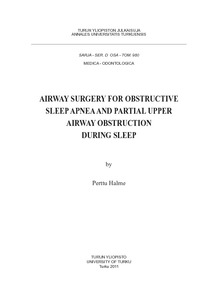Airway surgery for obstructive sleep apnea and partial upper airway obstruction during sleep
Halme, Perttu (2011-10-07)
Airway surgery for obstructive sleep apnea and partial upper airway obstruction during sleep
Halme, Perttu
(07.10.2011)
Annales Universitatis Turkuensis D 980 Turun yliopisto
Julkaisun pysyvä osoite on:
https://urn.fi/URN:ISBN:978-951-29-4735-5
https://urn.fi/URN:ISBN:978-951-29-4735-5
Kuvaus
Siirretty Doriasta
ei tietoa saavutettavuudesta
ei tietoa saavutettavuudesta
Tiivistelmä
This study analyzed the feasibility and efficacy of surgical therapies in patients with sleep-disordered breathing ranging from partial upper airway obstruction during sleep to severe obstructive sleep apnea syndrome. The surgical procedures evaluated were tracheostomy, laser-assisted uvulopalatoplasty (LUPP) and uvulopalatopharyngoplasty (UPPP) with laser or ultrasound scalpel.
Obstructive sleep apnea and partial upper airway obstruction during sleep were measured with the static charge-sensitive bed (SCSB) and pulse oximeter. The patients with severe obstructive sleep apnea syndrome were treated with tracheostomy. Palatal surgery was performed only if the upper airway narrowing occurred exclusively at the soft palate level in patients with partial upper airway obstruction during sleep. The ultrasound scalpel technique was compared to laser-assisted UPPP. The efficacy of LUPP to reduce partial upper airway obstruction during sleep was assessed and histology of uvulopalatal specimen was compared to body fat distributional parameters and sleep study findings.
Tracheostomy was effective therapy in severe obstructive sleep apnea. Partial upper airway obstruction and arterial oxyhemoglobin desaturation index during sleep decreased significantly after LUPP. The minimal retropalatal airway dimension increased and soft palate collapsibility decreased at the level where the velopharyngeal obstruction had occurred before the surgery. Ultrasound scalpel did not offer any significant benefits over the laser-assisted technique, except fewer postoperative haemorrhage events. The loose connective tissue as a manifestation of edema was the only histological finding showing correlation with partial upper airway obstruction parameters of SCSB.
Tracheostomy remains a life-saving therapy and also long-term option when adherence to CPAP fails in patients with obstructive sleep apnea syndrome. LUPP effectively reduces partial upper airway obstruction during sleep provided that obstruction at the other levels than the soft palate and uvula were preoperatively excluded. Technically the ultrasound scalpel or laser surgeries are equal. In patients with partial upper airway obstruction the loose connective tissue is more important than fat accumulation in the soft palate. This supports the hypothesis that edema is a primary trigger for aggravation of upper airway narrowing during sleep at the soft palate level and evolution towards partial or complete upper airway obstruction during sleep.
Obstructive sleep apnea and partial upper airway obstruction during sleep were measured with the static charge-sensitive bed (SCSB) and pulse oximeter. The patients with severe obstructive sleep apnea syndrome were treated with tracheostomy. Palatal surgery was performed only if the upper airway narrowing occurred exclusively at the soft palate level in patients with partial upper airway obstruction during sleep. The ultrasound scalpel technique was compared to laser-assisted UPPP. The efficacy of LUPP to reduce partial upper airway obstruction during sleep was assessed and histology of uvulopalatal specimen was compared to body fat distributional parameters and sleep study findings.
Tracheostomy was effective therapy in severe obstructive sleep apnea. Partial upper airway obstruction and arterial oxyhemoglobin desaturation index during sleep decreased significantly after LUPP. The minimal retropalatal airway dimension increased and soft palate collapsibility decreased at the level where the velopharyngeal obstruction had occurred before the surgery. Ultrasound scalpel did not offer any significant benefits over the laser-assisted technique, except fewer postoperative haemorrhage events. The loose connective tissue as a manifestation of edema was the only histological finding showing correlation with partial upper airway obstruction parameters of SCSB.
Tracheostomy remains a life-saving therapy and also long-term option when adherence to CPAP fails in patients with obstructive sleep apnea syndrome. LUPP effectively reduces partial upper airway obstruction during sleep provided that obstruction at the other levels than the soft palate and uvula were preoperatively excluded. Technically the ultrasound scalpel or laser surgeries are equal. In patients with partial upper airway obstruction the loose connective tissue is more important than fat accumulation in the soft palate. This supports the hypothesis that edema is a primary trigger for aggravation of upper airway narrowing during sleep at the soft palate level and evolution towards partial or complete upper airway obstruction during sleep.
Kokoelmat
- Väitöskirjat [2991]
